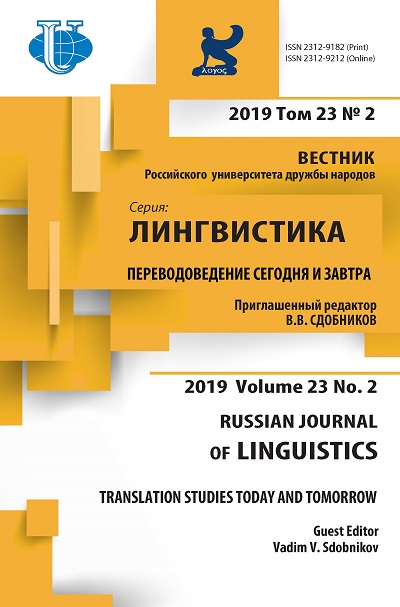Влияние инновационных технологий на перевод и переводоведение
- Авторы: Гамбье И.1,2
-
Учреждения:
- Университет Турку
- Балтийский федеральный университет им. И. Канта
- Выпуск: Том 23, № 2 (2019): Переводоведение сегодня и завтра
- Страницы: 344-361
- Раздел: ПЕРЕВОДОВЕДЕНИЕ СЕГОДНЯ И ЗАВТРА
- URL: https://journals.rudn.ru/linguistics/article/view/21211
- DOI: https://doi.org/10.22363/2312-9182-2019-23-2-344-361
Цитировать
Полный текст
Аннотация
Профессия письменного или устного переводчика претерпевает значительные и быстрые изменения. В течение долгого времени, хотя и не повсеместно, отрицалась сама потребность в переводе (за исключением перевода в политических или религиозных целях), перевод не рассматривался как деятельность, требующая определенных усилий и умений (перевод воспринимался как сугубо механическая работа по замене слов одного языка словами другого языка), либо перевод отрицался как профессия (считалось, что переводчики занимают подчиненное положение). Новые технологии привносят изменения в восприятие всего того, что относится к международной, многоязычной и мультимодальной коммуникации. В настоящей статье рассматриваются эти изменения, а также их последствия для обозначения и характеристики различных переводческих практик. Статья включает пять разделов. В первом мы укажем на то, что устный и письменный перевод являются одной из форм межкультурной коммуникации, затем мы остановимся на различных аспектах отрицания перевода в прошлом (или на отказе признать ценность перевода). В третьем разделе мы рассмотрим, каким образом и насколько технологии меняют переводческую деятельность и переводческий рынок. Эти изменения не сводятся только к развитию систем машинного перевода (начало которому было положено в 60-е годы прошлого века), к их числу относится и появление группового перевода, краудсорсинга и волонтерского перевода. Во многих случаях потребители перевода, даже не имеющие соответствующей квалификации в области переводческой деятельности, самостоятельно выполняют перевод. Эти изменения затрагивают не только технические аспекты переводческой деятельности, но и социально-экономические. Кроме того, разграничение и многообразие видов переводческой деятельности оказывают существенное воздействие на весьма разнообразный переводческий рынок. В четвертом разделе речь идет о существовании в переводоведении различных противоборствующих концепций и парадигм перевода. Наконец, мы рассматриваем организационные аспекты переводческой деятельности, поскольку сама институционализация перевода и переводоведения не может быть такой же, какой она была в эпоху существования формального консенсуса по поводу сущности переводческой деятельности.
Ключевые слова
Об авторах
Ив Гамбье
Университет Турку; Балтийский федеральный университет им. И. Канта
Email: yves.gambier@utu.fi
почетный профессор Университета Турку (Финляндия). Fi-20014 Turun Yliopisto, Финляндия; ул. Александра Невского, 14, Калининград, 236041, Россия
Список литературы
- Brems, E., Meylaerts, R. & van Doorslaer, L. (eds.) (2012). The Knowns unknowns of Translation Studies. Target, 24 (1).
- Buzelin, H. (2014). How devoted can translators be? Revisiting the subservience hypothesis. Target, 26 (1), 63-97.
- Chesterman, A. (2006). Interpreting the meaning of translation. In M. Suominen et al (eds.). A man of measure: Festschrift in homage of Fred Karlsson on his 60th birthday. University of Helsinki.
- Delisle, J. & Woodsworth, J. (eds.) (2012). Translators through history (Revised edition) 1st ed. 1995. Amsterdam: John Benjamins.
- Doorslaer, L. van & Flynn, P. (eds.) (2011). Eurocentrism in Translation Studies. Translation and Interpreting Studies (TIS), 6 (2).
- Gambier, Y. (2003). Working with relay: An old story and a new challenge. In L. Perez González (ed.). Speaking in tongues: Language across contexts and users, 47-66. PU València.
- Gambier, Y. (2007a). Réseaux de traducteurs/interprètes bénévoles. Meta, 52 (4), 658-672.
- Gambier, Y. (2007b). Y-a-t-il une place pour une socio-traductologie? In M. Wolf & A. Fukari (eds.). Constructing a sociology of translation, 205-217. Amsterdam: John Benjamins.
- Gambier, Y. (2012). Le traducteur défiguré? In E. Skibínska & N. Paprocka (eds.). Figure(s) du traducteur. Wroklow: PU (coll.Romanica Wratislaviensia, vol. 59).
- Gambier, Y. & Stecconi, U. (eds.) (2019). A World Atlas of Translation. Amsterdam: John Benjamins.
- Gile, D. (2010). Why TS matter. In Gile D., Gyde H. & Pokorn, N. (eds.). Why Translation Studies matter, 251-261. Amsterdam: John Benjamins.
- Gouadec, D. (2002). Profession: Traducteur. Paris: La Maison du traducteur. In English (2007) Translator as a profession. Amsterdam: John Benjamins.
- Heilbron J. & G. Sapiro (éds.) (2002). Traduire: les échanges littéraires internationaux. Actes de la Recherche en Sciences Sociales, 144.
- House, J. (2003). English as a global lingua franca. In L. Perez Gonzáles (ed.). Speaking in tongues: Language across contexts and users, 19-46. PU València.
- Kalinowski, I. (2002). La vocation au travail de traducteur. Actes de la Recherche en Sciences sociales, 144, 47-54.
- Lambert, J. (1989). La traduction, les langues et la communication de masse. Les ambiguïtés du discours international. Target, 1 (2), 215-237.
- Mossop, B. (2006). Has computerization changed translation? Meta, 51 (4), 787-792.
- Pym, A. (2004). The Moving Text. Amsterdam: John Benjamins.
- Pym, A. (2009). Natural and directional equivalence in theories of translation. In Gambier, Y. & van Doorslaer, L. (eds.). The Metalanguage of Translation, 81-104. Amsterdam: John Benjamins.
- Pym A., Shlesinger, M. & Z. Jettmarová (eds.) (2006). Sociocultural aspects of translating and interpreting. Amsterdam: John Benjamins.
- Ray, R & N. Kelly (2010). Reaching new markets through Transcreation. When translation just isn’t enough. Common Sense Advisory.
- Reiss, K & Vermeer, H. (2013). Towards a general theory of translational action: Skopos theory explained. Manchester: St Jerome.
- Ribera JM, S. Hausmann-Muela, KP. Grietens & E.Toomer (2008). Is the use of interpreters in medical consultations justified? A critical review of the literature. (www.passs-international.org).
- Sapiro, G. (dir.) (2008). Transaltio. Le marché de la traduction en France à l’heure de la mondialisation. Paris: Ed.du CNRS.
- Sapiro, G. (dir.) (2009). Les contradictions de la globalization éditoriale. Paris: Nouveau Monde éditions.
- Simeoni, D. (1998). The pivotal status of the translator’s habitus. Target, 10 (1), 1-39.
- TAUS, Translation Automation User Society. https://www.taus.net/ (2013). Translation Technology Landscape Report. Online, 74 p.
- Toury, G. (1995/2012). Descriptive Translation Studies and Beyond. Amsterdam: John Benjamins.
- Tymoczko, M. (2005). Trajectories of research in TS, Meta 50 (4), 1082-1097.
- Tymoczko, M. (2007). Enlarging Translation, Empowering Translators. Manchester: St Jerome.
- Venuti, L. (2008). The Translator’s Invisibility. A History of Translation. London: Routledge. 1st ed. 1995, 3rd ed. 2018.

















